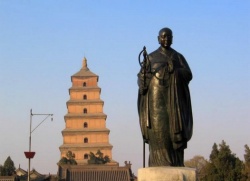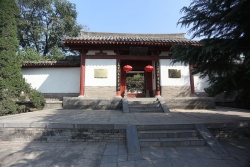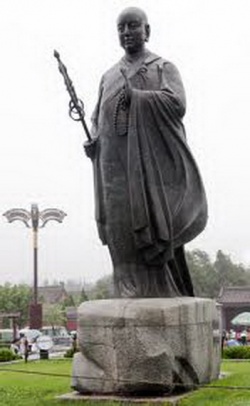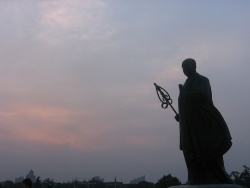Xuanzang
Xuanzang (Chinese: 玄奘; pinyin: Xuánzàng; Wade–Giles: Hsüan-tsang Sanskrit: ह्वेनसांग) (c. 596 or 602 – 664), born Chen Hui (simplified Chinese: 陈袆; traditional Chinese: 陳褘; pinyin: Chén Huī) or Chen Yi (simplified Chinese: 陈祎; traditional Chinese: 禕; pinyin: Chén Yī), was a Chinese Buddhist monk, scholar, traveler, and translator who described the interaction between China and India in the early Tang Dynasty.
Born in Henan province of China in 596 (or, 602 or 603), from boyhood he took to reading religious books, including the Chinese classics and the writings of ancient sages.
While residing in the city of Luoyang, Xuanzang entered Buddhist monkhood at the age of thirteen. Due to the political and social unrest caused by the fall of the Sui Dynasty, he went to Chengdu in Sichuan (Szechuan), where he was ordained at the age of twenty.
He later traveled throughout China in search of sacred books of Buddhism. At length, he came to Chang'an, then under the peaceful rule of Emperor Taizong of Tang.
Here Xuanzang developed the desire to visit India. He knew about Faxian's visit to India and, like him, was concerned about the incomplete and misinterpreted nature of the Buddhist scriptures that had reached China.
He became famous for his seventeen year overland journey to India, which is recorded in detail in the classic Chinese text Great Tang Records on the Western Regions, which in turn provided the inspiration for the classical novel Journey to the West, written by Wu Cheng'en during the Ming Dynasty, around nine centuries after Xuanzang's death.
Nomenclature, orthography and etymology
Less common romanizations of "Xuanzang" include Hhuen Kwan, Hiouen Thsang, Hiuen Tsiang, Hsien-tsang, Hsyan-tsang, Hsuan Chwang, Hsuan Tsiang, Hwen Thsang, Xuan ang, Xuan Zang, Shuen Shang, Yuan Chang, Yuan Chwang, and Yuen Chwang. Hsüan, Hüan, Huan and Chuang are also found.
"Sanzang" is the Chinese term for the Tripitaka scriptures, and in some English-language fiction and English translations of Journey to the West, Xuanzang is addressed as "Tripitaka".
Early life
Xuanzang was born Chen Hui (or Chen Yi) in 602 in Chenhe Village, Goushi Town (緱氏鎮), Luozhou (near present-day Luoyang, Henan) and died on 5 February 664 in Yuhua Palace (玉華宮, in present-day Tongchuan, Shaanxi).
His family was noted for its erudition for generations, and Xuanzang was the youngest of four children. His ancestor was Chen Shi (陳寔, 104-186), a minister of the Eastern Han Dynasty.
His great-grandfather Chen Qin (陳欽) served as the prefect of Shangdang (上黨; present-day Changzhi, Shanxi) during the Eastern Wei Dynasty; his grandfather [[Chen] Kang]] (陳康) was a professor in the Taixue Imperial Academy) during the Northern Qi Dynasty.
His father Chen Hui (陳惠) was a conservative Confucianist who served as the magistrate of Jiangling County (江陵縣) during the Sui Dynasty, but later gave up office and withdrew into seclusion to escape the political turmoil that gripped China towards the end of the Sui.
According to traditional biographies, Xuanzang displayed a superb intelligence and earnestness, amazing his father by his careful observance of the Confucian rituals at the age of eight.
Along with his brothers and sister, he received an early education from his father, who instructed him in classical works on filial piety and several other canonical treatises of orthodox Confucianism.
Although his household was essentially Confucian, at a young age, Xuanzang expressed interest in becoming a Buddhist monk as one of his elder brothers had done. After the death of his father in 611, he lived with his older brother Chen Su (陳素) (later known as Changjie 長捷) for five years at Jingtu Monastery (淨土寺) in Luoyang, supported by the Sui Dynasty state. During this time he studied Mahayana Buddhism and various early Buddhist schools, preferring Mahayana.
In 618, the Sui Dynasty collapsed and Xuanzang and his brother fled to Chang'an, which had been proclaimed as the capital of the Tang Dynasty, and thence southward to Chengdu, Sichuan.
Here the two brothers spent two or three years in further study in the monastery of Kong Hui, including the Abhidharmakosa-sastra (Abhidharma Storehouse Treatise).
When Xuanzang requested to take Buddhist orders at the age of thirteen, the abbot Zheng Shanguo made an exception in his case because of his precocious knowledge.
Xuanzang was fully ordained as a Monk in 622, at the age of twenty.
The myriad contradictions and discrepancies in the texts at that time prompted Xuanzang to decide to go to India and study in the cradle of Buddhism. He subsequently left his brother and returned to Chang'an to study foreign languages and to continue his study of Buddhism.
He began his Mastery of Sanskrit in 626, and probably also studied Tocharian. During this time, Xuanzang also became interested in the metaphysical Yogacara school of Buddhism.
Pilgrimage
In 629, Xuanzang reportedly had a dream that convinced him to journey to India.
The Tang Dynasty and Eastern Türk Göktürks were waging war at the time; therefore Emperor Taizong of Tang prohibited foreign travel. Xuanzang persuaded some Buddhist guards at the gates of Yumen and slipped out of the empire via Liangzhou(Gansu), and Qinghai province in 629.
He subsequently travelled across the Gobi Desert to Kumul (Hami), thence following the Tian Shan westward, arriving in Turpan in 630. Here he met the king of Turpan, a Buddhist who equipped him further for his travels with letters of introduction and valuables to serve as funds.
Moving further westward, Xuanzang escaped robbers to reach Yanqi, then toured the non-Mahayana monasteries of Kucha. Further west he passed Aksu before turning northwest to cross the Tian Shan's Bedel Pass into modern Kyrgyzstan. He skirted Issyk Kul before visiting Tokmak on its northwest, and met the great Khan of the Western Türk, whose relationship to the Tang emperor was friendly at the time. After a feast, Xuanzang continued west then southwest to Tashkent (Chach/Che-Shih), capital of modern Uzbekistan.
From here, he crossed the desert further west to Samarkand.
In Samarkand, which was under Persian influence, the party came across some abandoned Buddhist temples and Xuanzang impressed the local king with his preaching. Setting out again to the south, Xuanzang crossed a spur of the Pamirs and passed through the famous Iron Gates.
Continuing southward, he reached the Amu Darya and Termez, where he encountered a community of more than a thousand Buddhist monks.
Further east he passed through Kunduz, where he stayed for some time to witness the funeral rites of Prince Tardu, who had been poisoned.
Here he met the Monk Dharmasimha, and on the advice of the late Tardu made the trip westward to Balkh (modern day Afghanistan), to see the Buddhist sites and relics, especially the Nava Vihara, or Nawbahar, which he described as the westernmost monastic institution in the world.
Here Xuanzang also found over 3,000 non-Mahayana monks, including Prajnakara (般若羯羅 or 慧性), a Monk with whom Xuanzang studied early Buddhist scriptures.
He acquired the important Mahāvibhāṣa (大毗婆沙論) text here, which he later translated into Chinese.
Prajnakara then accompanied the party southward to Bamyan, where Xuanzang met the king and saw tens of non-Mahayana monasteries, in addition to the two large Bamyan Buddhas carved out of the rockface.
The party then resumed their travel eastward, crossing the Shibar Pass and descending to the regional capital of Kapisi (about 60 km north of modern Kabul), which sported over 100 monasteries and 6,000 monks, mostly Mahayana.
This was part of the fabled old land of Gandhara. Xuanzang took part in a religious debate here, and demonstrated his knowledge of many Buddhist schools.
Here he also met the first Jains and Hindus of his journey. He pushed on to Adinapur (later named Jalalabad) and Laghman, where he considered himself to have reached India. The year was 630.
India
Xuanzang left Adinapur, which had few Buddhist monks, but many stupas and monasteries.
His travels included, passing through Hunza and the Khyber Pass to the east, reaching the former capital of Gandharaa (Peshawar), on the other side. Peshawar was nothing compared to its former glory, and Buddhism was declining in the region.
Xuanzang visited a number of stupas around Peshawar, notably the Kanishka Stupa.
This Stupa was built just southeast of Peshawar, by a former king of the city. In 1908, it was rediscovered by D.B. Spooner with the help of Xuanzang's account.
Xuanzang left Peshawar and travelled northeast to the Swat Valley (the location of Oḍḍiyāna is disputed between Swat valley and Orissa).
Reaching Oḍḍiyāna, he found 1,400 old monasteries, that had previously supported 18,000 monks. The remnant monks were of the Mahayana school.
Xuanzang continued northward and into the Buner Valley, before doubling back via Shabaz Gharni to cross the Indus river at Hund.
Thereafter he headed to Taxila (呾叉始羅), a Mahayana Buddhist kingdom that was a vassal of Kashmir, which is precisely where he headed next.
Here he found 5,000 more Buddhist monks in 100 monasteries. He went to Kashmir in 631, met a talented Monk Samghayasas (僧伽耶舍), and studied there. Between 632 and early 633, he studied with various monks, including 14 months with Vinītaprabha (毘膩多缽臘婆 or 調伏光), 4 months with Candravarman (旃達羅伐摩 or 月胃), and "a winter and half a spring" with Jayagupta (闍耶毱多).
During this time, Xuanzang writes about the Fourth Buddhist council that took place nearby, ca. 100 AD, under the order of King Kanishka of Kushana.
He visited Chiniot and Lahore as well and provided the earliest writings available on the ancient cities. In 634, Xuanzang arrived in Matipura (秣底補羅), nowadays known as Mandawar.
In 634, he went east to Jalandhar in eastern Punjab, before climbing up to visit predominantly non-Mahayana monasteries in the Kulu valley and turning southward again to Bairat and then Mathura, on the Yamuna river. Mathura had 2,000 monks of both major Buddhist branches, despite being Hindu-dominated.
Xuanzang travelled up the river to Srughna before crossing eastward to Matipura, where he arrived in 635, having crossed the river Ganges.
At Matipura Monastery, Xuanzang studied under Mitrasena. From here, he headed south to Sankasya (Kapitha), said to be where Buddha descended from heaven, then onward to the northern Indian emperor Harsha's grand capital of Kanyakubja (Kannauj).
It is believed he also visited Govishan present day Kashipur in the Harsha era, in 636, Xuanzang encountered 100 monasteries of 10,000 monks (both Mahayana and non-Mahayana), and was impressed by the king's patronage of both scholarship and Buddhism.
Xuanzang spent time in the city studying early Buddhist scriptures, before setting off eastward again for Ayodhya (Saketa), homeland of the Yogacara school.
Xuanzang now moved south to Kausambi (Kosam), where he had a copy made from an important local image of The Buddha.
Xuanzang now returned northward to Sravasti, travelled through Terai in the southern part of modern Nepal (here he found deserted Buddhist monasteries) and thence to Kapilavastu, his last stop before Lumbini, the birthplace of Buddha.
In 637, Xuanzang set out from Lumbini to Kusinagara, the site of Buddha's death, before heading southwest to the deer park at Sarnath where Buddha gave his first sermon, and where Xuanzang found 1,500 resident monks.
Travelling eastward, at first via Varanasi, Xuanzang reached Vaisali, Pataliputra (Patna) and Bodh Gaya. He was then accompanied by local monks to Nalanda, the great Buddhist university of Indian state of Bihar, where he spent at least the next two years. He was in the company of several thousand scholar-monks, whom he praised.
Xuanzang studied logic, grammar, Sanskrit, and the Yogacara school of Buddhism during his time at Nalanda. René Grousset notes that it was at Nalanda (where an "azure pool winds around the monasteries, adorned with the full-blown cups of the blue lotus;
the dazzling red flowers of the lovely kanaka hang here and there, and outside groves of mango trees offer the inhabitants their dense and protective shade") that Xuanzang met the Venerable Silabhadra, the monastery's superior. Silabhadra had dreamt of Xuanzang's arrival and that it would help spread far and wide the Holy Law.
Grousset writes: "The Chinese pilgrim had finally found the omniscient master, the incomparable metaphysician who was to make known to him the ultimate secrets of the idealist systems...
The founders of Mahayana idealism, Asanga and Vasubandhu...Dignaga...Dharmapala had in turn trained Silabhadra.
Siladhadra was thus in a position to make available to the Sino-Japanese world the entire heritage of Buddhist idealism, and the Siddhi Hiuan Tsang's great philosophical treatise...is none other than the Summa of this doctrine, the fruit of seven centuries of Indian [[[Buddhist]]] thought."
From Nalanda, Xuanzang travelled through several countries, including Campā, to the capital of Pundravardhana, identified with modern Mahasthangarh, in Bangladesh.
There Xuanzang found 20 monasteries with over 3,000 monks studying both the Hinayana and the Mahayana.
One of them was the Vāśibhã Monastery (Po Shi Po), where he found over 700 Mahayana monks from all over East India.
He also visited a Stupa originally built by Ashoka Somapura Mahavihara at Paharpur in the district of Naogaon,Bangladesh.
After crossing the Karatoya, he went east to the ancient city of Pragjyotishpur (modern Guwahati) in the kingdom of Kamarupa (modern Assam) at the invitation of its Buddhist king Kumar Bhaskaravarman.
Later, the king escorted Xuanzang back to the Kannauj at the request of king Harshavardhana, who was an ally of Kumar Bhaskaravarman, to attend a great Buddhist council there which was attended by both the kings.
Xuanzang turned southward and travelled to Andhradesa to visit the famous Viharas at Amaravati and Nagarjunakonda. He stayed at Amaravati and studied 'Abhidhammapitakam'.
He observed that there were many Viharas at Amaravati and some of them were deserted. He later proceeded to Kanchi, the imperial capital of Pallavas and a strong centre of Buddhism.
Traveling through the Khyber Pass of the Hindu Kush, Xuanzang passed through Kashgar, Khotan, and Dunhuang on his way back to China. He arrived in the capital, Chang'an, on the seventh day of the first month of 645, and a great procession celebrated his return.
Return to China
On his return to China in AD 645, Xuanzang was greeted with much honor but he refused all high civil appointments offered by the still-reigning emperor, Emperor Taizong of Tang.
Instead, he retired to a monastery and devoted his energy to translating Buddhist texts until his death in AD 664.
Chinese Buddhism (influence)
During Xuanzang's travels, he studied with many famous Buddhist masters, especially at the famous center of Buddhist learning at Nālanda University. When he returned, he brought with him some 657 Sanskrit texts.
With the emperor's support, he set up a large translation bureau in Chang'an (present-day Xi'an), drawing students and collaborators from all over East Asia. He is credited with the translation of some 1,330 fascicles of scriptures into Chinese.
His strongest personal interest in Buddhism was in the field of Yogācāra (瑜伽行派), or Consciousness-only (唯識).
The force of his own study, translation and commentary of the texts of these traditions initiated the development of the Faxiang school (法相宗) in East Asia.
Although the school itself did not thrive for a long time, its theories regarding perception, consciousness, Karma, Rebirth, etc. found their way into the doctrines of other more successful schools.
Xuanzang's closest and most eminent student was Kuiji (窺基) who became recognized as the first patriarch of the Faxiang school.
Xuanzang's logic, as described by Kuiji, was often misunderstood by scholars of Chinese Buddhism because they lack the necessary background in Indian logic. Another important disciple was the Korean Monk Woncheuk.
Xuanzang was known for his extensive but careful translations of Indian Buddhist texts to Chinese, which have enabled subsequent recoveries of lost Indian Buddhist texts from the translated Chinese copies.
He is credited with writing or compiling the Cheng Weishi Lun as a commentary on these texts. His translation of The Heart Sutra became and remains the standard in all East Asian Buddhist sects.
He also founded the short-lived but influential Faxiang school of Buddhism. Additionally, he was known for recording the events of the reign of the northern Indian emperor, Harsha.
The Perfection of Wisdom Sutra
Xuanzang returned to China with three copies of the Mahaprajnaparamita Sutra.
Xuanzang, with a team of disciple translators, commenced translating the voluminous work in 660 CE, using all three versions to ensure the integrity of the source documentation.
Xuanzang was being encouraged by a number of his disciple translators to render an abridged version.
After a suite of dreams quickened his decision, Xuanzang determined to render an unabridged, complete volume, faithful to the original of 600 chapters.
Autobiography and biography
In 646, under the Emperor's request, Xuanzang completed his book Great Tang Records on the Western Regions (大唐西域記), which has become one of the primary sources for the study of medieval Central Asia and India.
This book was first translated into French by the Sinologist Stanislas Julien in 1857.
There was also a biography of Xuanzang written by the Monk Huili (慧立).
Both books were first translated into English by Samuel Beal, in 1884 and 1911 respectively.
An English translation with copious notes by Thomas Watters was edited by T.W. Rhys Davids and S.W. Bushell, and published posthumously in London in 1905.
Legacy
Xuanzang's work, the Great Tang Records on the Western Regions, is the longest and most detailed account of the countries of Central and South Asia that has been bestowed upon posterity by a Chinese Buddhist pilgrim.
While his main purpose was to obtain Buddhist books and to receive instruction on Buddhism while in India, he ended up doing much more.
He has preserved the records of political and social aspects of the lands he visited.
His record of the places visited by him in Bengal — mainly Raktamrittika near Karnasuvarna, Pundranagara and its environs, Samatata and Tamralipti — have been very helpful in the recording of the archaeological history of Bengal. His account has also shed welcome light on the history of 7th century Bengal, especially the Gauda kingdom under Shashanka, although at times he can be quite partisan.
Xuanzang obtained and translated 657 Sanskrit Buddhist works.
He received the best education on Buddhism he could find throughout India.
Much of this activity is detailed in the companion volume to Xiyu Ji, the Biography of Xuanzang written by Huili, entitled the Life of Xuanzang.
His version of The Heart Sutra is the basis for all Chinese commentaries on the Sutra, and recitations throughout China, Korea and Japan.
His style was, by Chinese standards, cumbersome and overly literal, and marked by scholarly innovations in terminology; usually, where another version by the earlier translator Kumārajīva exists, Kumārajīva's is more popular.
Xuanzang's journey along the so-called Silk Road, and the legends that grew up around it, inspired the Ming novel Journey to the West, one of the great classics of Chinese literature.
The Xuanzang of the novel is the reincarnation of a disciple of Gautama Buddha, and is protected on his journey by three powerful disciples.
One of them, the monkey, was a popular favourite and profoundly influenced Chinese culture and contemporary Japanese manga and anime (including the popular Dragon Ball and Saiyuki series), and became well known in the West by Arthur Waley's translation and later the cult TV series Monkey.
In the Yuan Dynasty, there was also a play by Wu Changling (吳昌齡) about Xuanzang obtaining scriptures.
Relics
A skull relic purported to be that of Xuanzang was held in the Temple of Great Compassion, Tianjin until 1956 when it was taken to Nalanda - allegedly by the Dalai Lama - and presented to India.
The relic is now in the Patna museum. The Wenshu Monastery in Chengdu, Sichuan province also claims to have part of Xuanzang's skull.
Part of Xuanzang's remains were taken from Nanjing by soldiers of the Imperial Japanese Army in 1942, and are now enshrined at Yakushi-ji in Nara, Japan.






